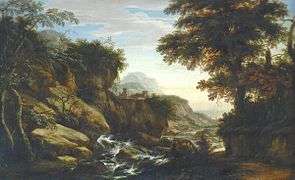Renier Meganck

Renier Meganck[1] (Brussels, baptised on 14 September 1637 – Vienna, 27 November 1690) was a Flemish painter and printmaker known for his landscapes and still lifes. After training in Brussels and working in Ghent, he emigrated to Vienna where he was active as a painter to the Imperial court and an art dealer.[2] His patrons included Karl Eusebius, Prince of Liechtenstein who was the founder of the Liechtenstein collection.[3]
Life

Meganck was born in Brussels where he was baptised in the Church of Our Lady of the Chapel on 14 September 1637. His parents were Anton (Antoni) Meganck and Magdalena van Grimberghen.[4] In 1656 he became a pupil of Leo van Heil in Brussels.[2] Leo van Heil was a canvas painter and miniature painter as well as an architect. After completing his studies with van Heil, Meganck was recorded in Ghent between 1661 and 1669 where he had become a master of the local Painter’s Guild.
By 1671 Meganck had moved to Vienna where he resided for the rest of his life.[3] In Vienna he likely first worked in the workshop of Franciscus van der Steen, a compatriot from Antwerp. Franciscus van der Steen was one of the many artists of the Southern Netherlands who had followed Archduke Leopold Wilhelm, the art loving governor of the Southern Netherlands, upon his return to Vienna in 1656.[3][5] Franciscus van der Steen was principally active as a reproductive engraver.[6] Meganck is first recorded in Vienna in 1671 when he acted as a witness and sealed the last will of Franciscus van der Steen. Van der Steen died not much later in early 1672.[5]
In Vienna Meganck enjoyed high patronage and he was appointed painter to the Imperial court ('kaiserlicher Kammermaler').[7] Karl Eusebius, the second Prince of Liechtenstein, became a prominent patron of Meganck. The prince is regarded as the founder of the renowned Liechtenstein collection, which forms the basis of the collection of the Liechtenstein Museum. Meganck did not only sell his own paintings to the Prince buy also acted as the Prince's agent in the purchase of works by other artists. It is known that Meganck arranged for the sale of four landscapes by the Dutch painter Hans de Jode to the Prince.[5]
Meganck died in Vienna on 27 November 1690.[2]
Work

Meganck was mainly known as a landscape painter but he also painted the occasional hunting still life and vanitas still life.[2] He was further active as an etcher. Six engravings of mountain landscapes by him are recorded.[8]
Meganck was held in high esteem as a landscape painter. His works show a certain similarity with the works of Hans de Jode and it is possible the artist spent time in Hans de Jode's workshop.[5] For the Archbishop's castle in Kroměříž (now in the Czech Republic) (not far from Brno) Meganck painted a set of lunette-shaped landscapes, which are still in situ.[9] Landscapes by Meganck are part of the collections of Austrian museums, such as the Kunsthistorisches Museum in Vienna, the Liechtenstein Museum in Vienna and the Harrach Collection in Schloss Rohrau.[3]
Only three still lifes by Meganck are known, all three signed. Two of them are still lifes with dead game and one is a vanitas still life dated to 1664.[3]
Lunette-shaped landscapes in Kroměříž Castle
References
- ↑ Also known as Renier Megan, Reinier Megan, Renier Meganet, Reinier Meganet, Renier Mefanck, Reinier Mefanck, Renier Meeganck, Reinier Meeganck, Reinier Meganck, Reinhart Megan, Megonetz
- 1 2 3 4 Renier Meganck at the Netherlands Institute for Art History (in Dutch)
- 1 2 3 4 5 Renier Meganck, Hunting still life of birds at Jean Moust
- ↑ Theodor von Frimmel, Kleine Galeriestudien, Volume 3, pt. 1, Publisher: C.C. Buchner, 1898, pp. 634-635 (in German)
- 1 2 3 4 Guido Messling, Point of View #14 at the Kunsthistorisches Museum
- ↑ Franciscus van der Steen at the Netherlands Institute for Art History (in Dutch)
- ↑ Die Gemäldegalerie : alte Meister, Kunsthistorische Sammlungen des allerhöchsten Kaiserhauses. Gemäldegalerie, A. Holzhausen, Vienna, 1907, p. 265 (in German)
- ↑ Wurzbach, Alfred von (Ed.), Niederländisches Künstlerlexikon (Vol. 2): L - Z, Amsterdam, 1910, p. 130-131 (in German)
- ↑ Restoration of the Selected Paintings and Furniture at Kroměříž Castle
External links
